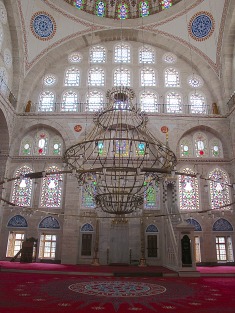“The Edirne Gate”
Edirnekapı is the district right beside the Theodosian Land Walls at the end of Fevzi Paşa Cami, the main road through Fatih. Most people come here to visit the Chora Church (Kariye Cami) with its spectacular Byzantine mosaics and murals. Just a short walk away in Karagümrük-Draman the Fethiye Cami is an almost equally impressive converted Byzantine church but goes much less visited.
But this area is not just about Byzantine churches and ancient walls. It is also home to one of Sinan’s most magnificent works, the Mihrimah Sultan Cami, which was built on top of the sixth of Constantinople’s seven hills.
Edirnekapı is also a good place to start exploring the Theodosian City Walls if you just fancy a taster rather than walking along them from end to end.
St Saviour in Chora Church (Kariye Cami)
To find the Chora Church you need to get off the bus towards the end of Fevzi Paşa Caddesi and then head north along Salma Topruk Caddesi. It’s well signposted.
Today it takes a lot of imagination to conjure up the early years of this Byzantine church-turned-mosque-turned-museum-turned-mosque again. At the time that the original church was constructed it stood in open countryside outside the original Constantinian city walls, hence the epithet “chora” which meant “country” in Greek. But that church was destroyed by an earthquake and by the time it was rebuilt between 1077 and 1081 it stood well inside the newer Theodosian walls.
That church was, in turn, much rebuilt, especially between 1315 and 1321 when the damage done by the Fourth Crusaders was repaired and an outer narthex and parecclesion (side chapel) added. That work was commissioned and paid for by Theodore Metochites (1270-1332), an advisor to the Emperor Andronikos II Paleologos. It is to Theodore that we owe the lavish decoration in mosaic and fresco that covers the walls and ceilings. The grand vizier Atik Ali Paşa had these decorations whitewashed over as part of his conversion of the church into a mosque in 1511.
In 1947 the church-mosque was turned into a museum (closed Wednesdays). The Byzantine Institute of America then spent 10 years uncovering the original decorations and restoring them to their current splendour, at its most vivid in the parecclesion. In 2020, shortly after Ayasofya was turned back into a mosque, the Chora was too. It then closed for lengthy “restoration”. It is expected to reopen in February 2024 with a system of curtains and screens to conceal the decoration from worshippers. Presumably these will be removed in between prayer times although it is hard to see how this will work.
Chora Church stands in a pleasant residential neighbourhood where much of the old housing stock has been renovated. The square facing it may be full of tables belonging to the “Ottoman” cafe there but a visit here does offer a glimpse of a part of the old city which is still just about managing to hang onto authentic life, complete with coal merchants’ stock yards.
 Mihrimah Sultan Cami
Mihrimah Sultan Cami
Most people are in such a rush to visit the Chora Church that they completely overlook the huge and beautiful Mihrimah Sultan Mosque built by Sinan between 1562 and 1565 for Mihrimah Sultan, the favourite daughter of Sultan Süleyman the Magnificent. Perched on top of İstanbul’s Sixth Hill just inside Edirnekapı, it dominates the landscape for miles around despite having only a single minaret.
The mosque complex, which included a seminary, primary school and hamam, was badly damaged by earthquakes in 1766 and 1894 but the mosque itself, restored in the 2010s, is spectacular, its interior drenched with light from the many windows that pierce the walls. The double hamam makes a good alternative to the more visited Turkish baths closer to Sultanahmet.
Immediately across the street in a small garden is the Greek Orthodox Church of Hagios Nikolaos, designed in 1831 by an architect from Kayseri, with a slightly newer schoolhouse attached to it. Also next door to its is the Armenian Church of Surp Nikoğayos which may be a century or so older. I’ve never known either church be unlocked.
Tucked up against the wall just behind the mosque used to be the long-lived Roma neighbourhood of Sulukule that featured in the James Bond film From Russia With Love. In 2008 it was decreed that the old neighbourhood should be demolished and its residents moved miles away to Taşoluk. An entirely new district of executive housing now stands in its place.
Eating
There’s not a lot of choice of good places to eat and drink in the vicinity although the faux Ottoman Pembe Kösk across from the Kariye Cami does a good enough light lunch or snack meal.
 New-look Sulukule, 2012
New-look Sulukule, 2012
Transport info
 “Welcome to the Dead City”. Sulukule during demolition, 2009
“Welcome to the Dead City”. Sulukule during demolition, 2009

